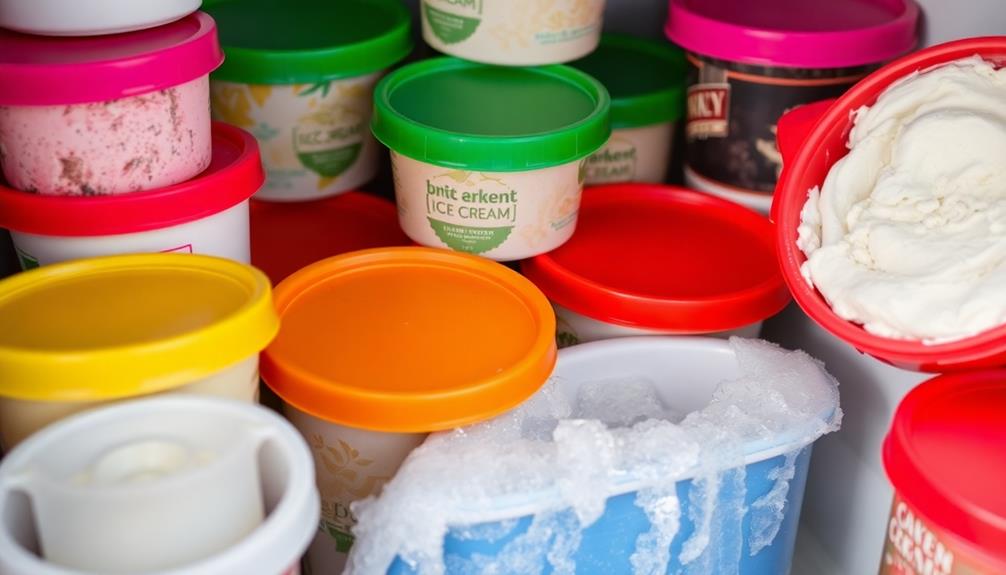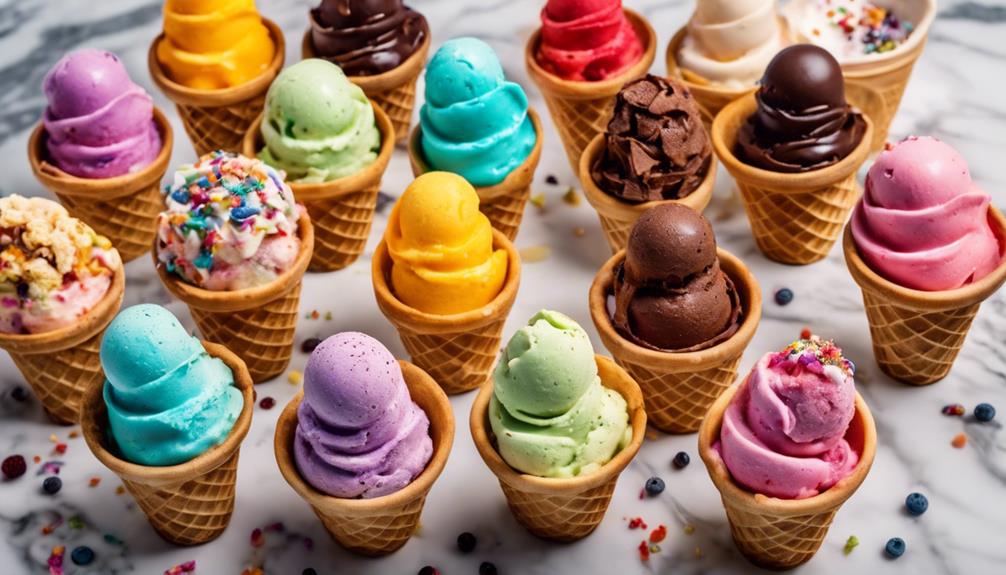To develop and test new ice cream flavors, start by understanding flavor profiles and balancing primary tastes like sweet and sour. Experiment with unique ingredients, including herbs and spices, for exciting combinations. Conduct taste tests with a diverse group to gather honest feedback, using a rating scale for clarity. Adjust your flavors based on this input and retest to refine. Keep meticulous notes on ingredients and processes for consistency. Finally, guarantee quality and safety through strict standards. There's much more to explore that can make your flavor development truly exceptional.
Key Takeaways
- Experiment with diverse ingredients and flavor profiles to create unique ice cream flavors that appeal to current consumer trends.
- Conduct taste tests with a varied participant group, using a rating scale to quantify feedback on flavor preferences.
- Gather and analyze feedback systematically to refine flavors, adjusting based on consumer and peer input for market readiness.
- Ensure strict adherence to food safety standards and quality assurance protocols throughout the ice cream production process.
- Maintain meticulous documentation of successful flavors, including ingredient ratios and feedback, to ensure consistency in future batches.
Understanding Flavor Profiles

When developing ice cream flavors, you must consider the balance of primary tastes—sweet, sour, salty, bitter, and umami—to create a harmonious profile. Each flavor plays an essential role in how your ice cream is perceived, influencing everything from texture to overall enjoyment. Striking the right balance can elevate your ice cream flavors beyond the ordinary.
To enhance complexity, think about incorporating complementary and contrasting ingredients. Pairing sweet with salty or fruity with creamy can lead to exciting and unexpected flavor combinations.
Don't underestimate the power of aromatic compounds either; they contribute considerably to perceived taste, with up to 80% of flavor coming from smell.
Stay attuned to consumer preferences and current trends, as they can guide your flavor profile development. Flavors that resonate with your target audience often lead to successful product launches.
Experimenting With Ingredients
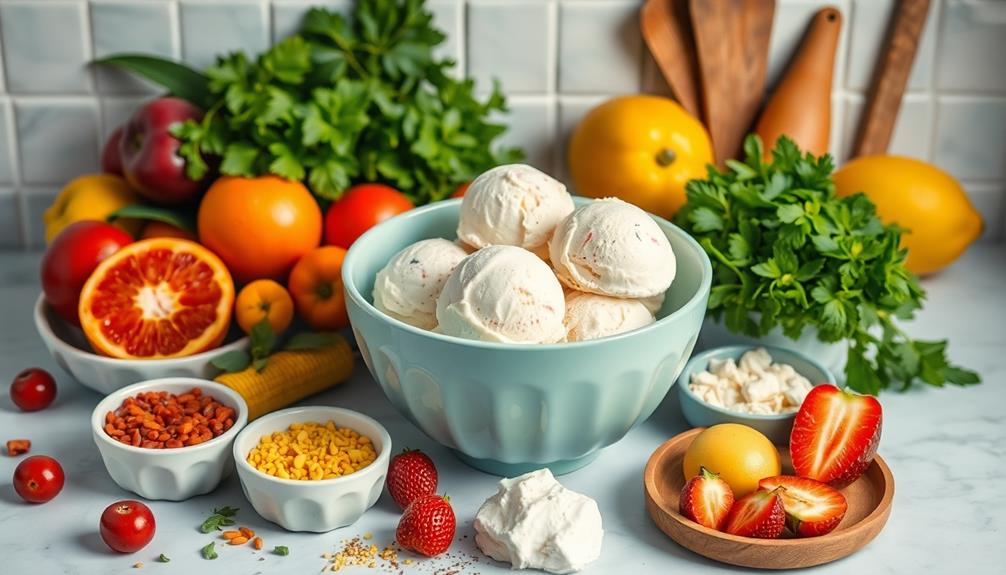
Experimentation is the heart of developing innovative ice cream flavors, allowing you to push boundaries and discover unexpected delights. When you start experimenting with ingredients, think beyond the usual. Consider herbs and spices; for instance, a curry coconut ice cream can surprise your palate with a unique flavor combination that challenges conventions.
Understanding flavor pairings is essential. Balancing sweet and savory elements can elevate your ice cream's taste profile. Focus on learning during this phase, rather than market readiness. This creative freedom lets you explore a range of possibilities without the pressure to succeed immediately.
Don't underestimate the power of feedback from peers in your test kitchen. Their insights can help you assess new flavor combinations and refine your recipes. Collaboration often leads to breakthroughs that you mightn't achieve alone.
Lastly, remember that acceptance takes time. Some flavors mightn't resonate with consumers right away, but patience and persistence are key. Keep experimenting, and don't shy away from revisiting flavors that initially flopped. Each attempt brings you closer to finding that perfect scoop that delights your audience.
Conducting Taste Tests
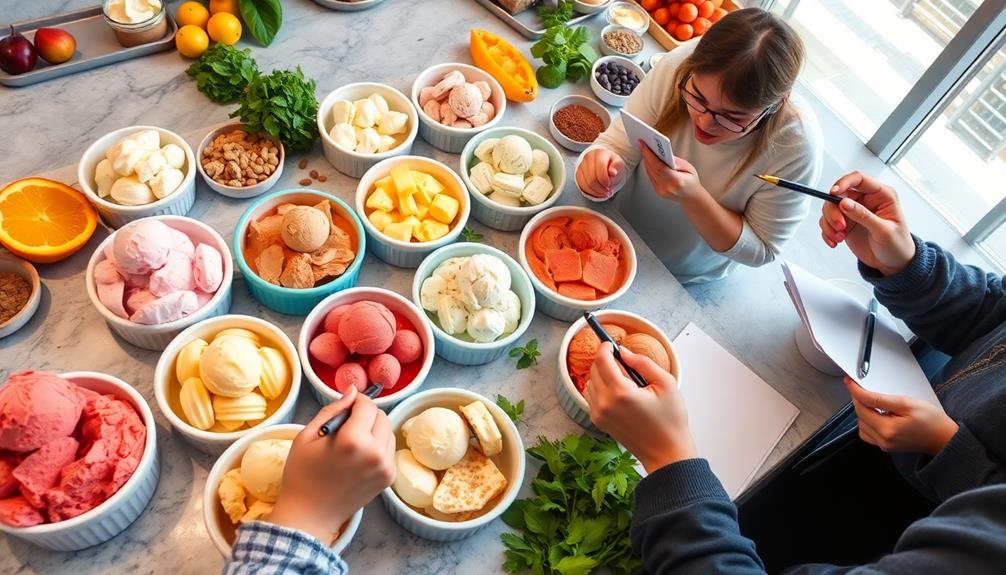
To successfully gauge the appeal of your innovative ice cream flavors, conducting taste tests is essential. Start by gathering a diverse group of participants who can provide honest feedback, keeping in mind that some individuals may have dietary restrictions affecting their preferences, such as lactose intolerance or gluten allergies. Each participant will receive a plastic cup and spoon to sample various flavors.
Encourage them to write down the flavors they taste and rate them on a scale of 1-5, which quantifies their preferences and helps you identify standout flavors.
During the tasting process, have participants sample multiple flavors in sequence. This approach guarantees they experience the full range of options and can compare them effectively. After the taste test, tally the votes to determine the best flavors in different categories. This fosters a competitive yet fun atmosphere, making the experience enjoyable for everyone involved.
Don't forget about the leftover ice cream! Make it available for additional sampling, guaranteeing that no delicious flavor goes unappreciated.
Conducting these taste tests not only helps refine your recipes but also builds excitement around your new creations. Embrace the feedback, and let it guide you toward developing ice cream flavors that everyone will love.
Gathering Feedback and Adjusting

Gathering feedback from your peers is key to refining your ice cream flavors.
By incorporating their insights, you can make informed adjustments and enhance your creations.
Importance of Peer Input
Peer input plays an essential role in developing new ice cream flavors, as it brings together diverse perspectives that enhance both quality and appeal. When you gather your team for brainstorming sessions, you'll find that sharing thoughts on potential flavor combinations sparks creativity and innovation. Each member can contribute unique ideas, leading to unexpected and exciting flavor profiles.
In the test kitchen, it's time to put these ideas to the test. Peers taste the various ice cream iterations and provide critical peer feedback that's vital for evaluating each flavor's potential. This constructive criticism helps you identify which combinations resonate well with potential consumers.
You may discover that some flavors need tweaking or even complete overhauls based on the input you receive. Understanding the importance of peer input can lead to successful flavor innovations. Some flavors might require time and adjustments before they find their place in the market.
Iterative Flavor Refinement Process
The iterative flavor refinement process is essential for transforming initial ice cream prototypes into market-ready delights. As a food scientist, you'll need to gather feedback during tasting sessions with peers to assess new flavor combinations. This input helps you determine market appeal and refine your creations.
Regular brainstorming sessions with a diverse team can spark creative ideas and provide valuable insights. Being open-minded and willing to experiment with unexpected flavors is vital for innovation. Collaborating with the Consumer Insight team allows you to understand consumer preferences and trends, guiding necessary flavor adjustments.
Here's a quick overview of the iterative flavor refinement steps:
| Step | Description |
|---|---|
| 1. Prototype Creation | Develop initial ice cream flavors for tasting. |
| 2. Feedback Gathering | Collect input from peers and consumers. |
| 3. Analysis | Assess feedback for taste and texture insights. |
| 4. Adjustment | Modify flavors based on gathered input. |
| 5. Retesting | Conduct further tastings to evaluate changes. |
Documenting Successful Flavors
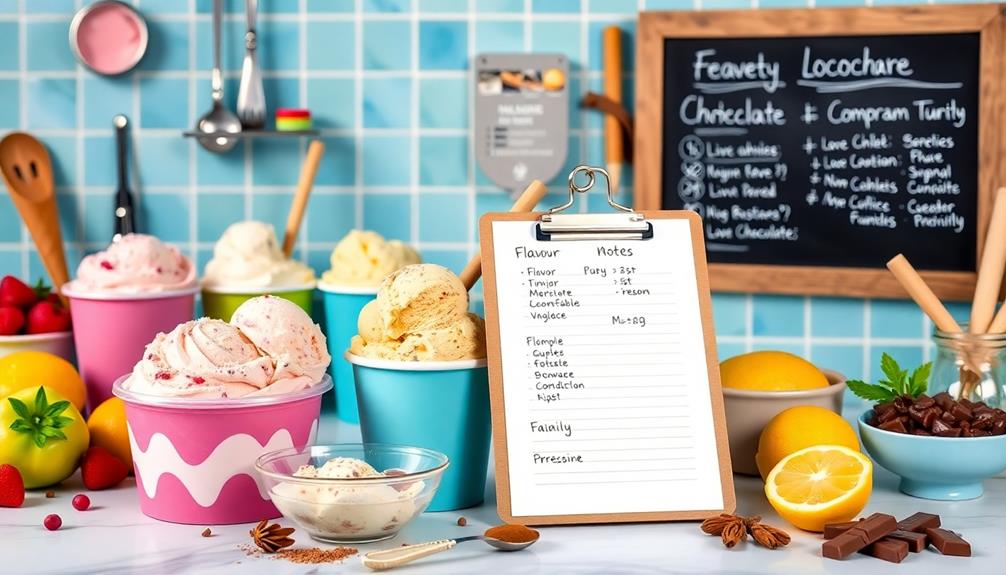
Successful ice cream flavor development hinges on meticulous documentation of your ingredients, ratios, and processes. This guarantees consistency in future batches and helps you replicate your best creations. When you're documenting successful flavors, maintain detailed records of each experiment, noting what worked and what didn't.
During flavor testing, gather feedback from a diverse group of tasters. Their varied preferences can provide valuable insights, so be sure to record their sensory experiences for later analysis. Utilize scorecards during taste tests to systematically evaluate different flavors based on criteria like taste, texture, and overall appeal. This approach helps you identify standout combinations that resonate with consumers.
After introducing new flavors, analyze sales data and customer feedback to gauge market trends. This information can guide your future flavor development efforts.
Additionally, maintain a flavor archive that includes notes on both successful and unsuccessful experiments. This archive not only aids in refining your creative process but also serves as a wellspring of inspiration for new flavor ideas.
With these practices in place, you'll enhance your ability to develop and document successful flavors effectively.
Ensuring Quality and Safety
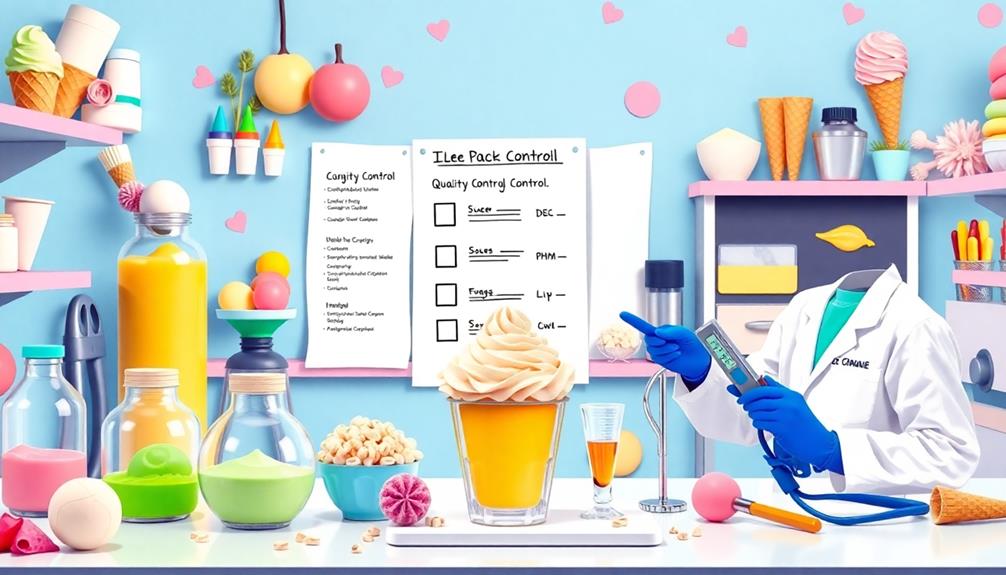
In the world of ice cream production, guaranteeing quality and safety is paramount for maintaining consumer trust and product integrity. You must adhere to strict food safety standards throughout the entire process. This includes proper sanitation practices and temperature control during mixing and storage to prevent contamination.
Regular testing of your ingredients for allergens, contaminants, and spoilage is essential in maintaining product integrity and consumer safety. Compliance with regulatory guidelines from organizations like the FDA is non-negotiable. Be vigilant about labeling requirements and permissible ingredient lists to avoid any legal repercussions.
Implementing quality assurance protocols can help you evaluate your ice cream's taste, texture, and appearance effectively. Trained tasters should assess each batch to guarantee consistency.
Additionally, consider implementing traceability systems. These systems allow you to track ingredient sources, making it easier to monitor compliance with safety standards throughout your supply chain.
Frequently Asked Questions
How Do You Become an Ice Cream Taste Tester?
To become an ice cream taste tester, you'll need a relevant degree and practical experience. Develop your palate by avoiding strong flavors, and stay updated on industry trends to excel in this delicious career.
How to Do an Ice Cream Taste Test?
Did you know that 90% of Americans love ice cream? To conduct a taste test, gather your participants, provide cups, and have them rate flavors on a scorecard, ensuring a fun and organized evaluation process.
What New Ice Cream Flavor Would You Invent and Why?
You'd invent a spicy mango chili ice cream because it combines tropical sweetness with a kick. This unique flavor taps into current trends, offering a revitalizing twist that excites adventurous palates and stands out in the market.
How Much Does an Ice Cream Taste Tester?
An ice cream taste tester earns about $68,970 annually. If you're interested in this career, you'll need a degree in food science and practical experience to enhance your skills and maintain a healthy palate.
Conclusion
Just like a chef crafting a masterpiece, developing new ice cream flavors is a delightful journey. Embrace the adventure of mixing unexpected ingredients, and let your taste buds be the compass guiding you. Each scoop tells a story, and with every taste test, you're refining your narrative. Remember, the sweetest rewards come from the feedback you gather. So, keep experimenting, documenting, and ensuring quality—your next flavor could be the cherry on top of your creamy creation!

